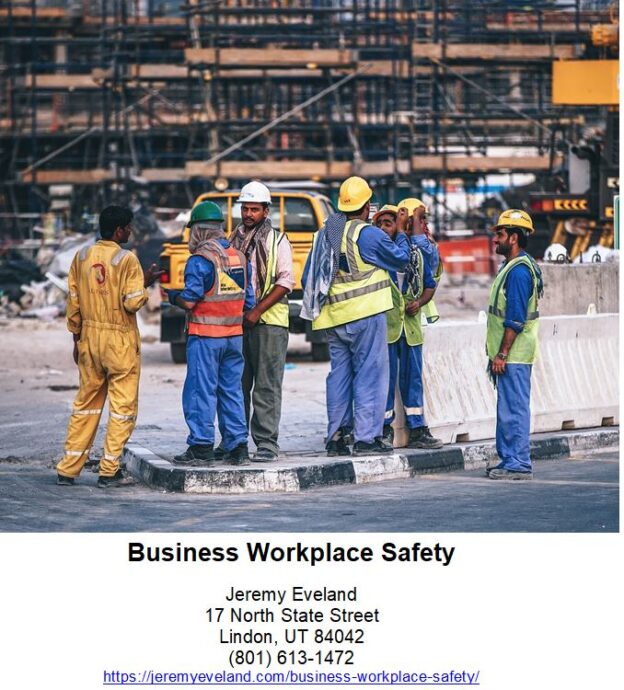In today’s business landscape, the importance of workplace safety compliance cannot be overstated. As a business owner or manager, it is your legal responsibility to ensure that your workplace is safe and that all necessary measures are taken to prevent accidents and injuries. Failure to comply with workplace safety regulations can result in costly fines, legal liabilities, and damage to your company’s reputation. By prioritizing workplace safety compliance, not only are you protecting your employees, but you are also safeguarding the long-term success and stability of your business. In this article, we will delve into the essential aspects of workplace safety compliance, providing you with a comprehensive understanding of the topic and the tools you need to ensure a safe and secure work environment for your employees.

Understanding Workplace Safety Compliance
In today’s fast-paced and competitive business environment, workplace safety compliance is of utmost importance. As a business owner or manager, it is your responsibility to ensure the well-being and safety of your employees. Failing to comply with workplace safety regulations not only puts your employees at risk but can also lead to severe legal consequences for your business. This comprehensive guide will help you understand the importance of workplace safety compliance, the legal requirements, and how to create a culture of safety in your workplace.
Importance of Workplace Safety Compliance
Workplace safety compliance is not just a legal obligation, but it is also crucial for the overall success and prosperity of your business. By prioritizing the safety and well-being of your employees, you create a positive work environment that promotes productivity, boosts employee morale, and reduces the risk of accidents and injuries. Furthermore, maintaining workplace safety compliance demonstrates your commitment to upholding ethical and professional standards, which can enhance your business reputation and attract clients and investors.
Definition of Workplace Safety Compliance
Workplace safety compliance refers to the adherence to laws, regulations, and standards set forth by government agencies and industry-specific organizations to ensure the safety and health of employees in the workplace. This includes implementing safety policies and procedures, conducting risk assessments, providing training and education programs, using personal protective equipment (PPE), and maintaining proper documentation and record-keeping. Compliance is essential for preventing workplace accidents, injuries, and illnesses, and for ensuring a safe and healthy work environment for all employees.
Benefits of Workplace Safety Compliance
Complying with workplace safety regulations offers numerous benefits to both employers and employees. First and foremost, it helps prevent accidents, injuries, and illnesses, reducing the human and financial costs associated with workplace incidents. By creating a safe work environment, you can also improve employee morale and job satisfaction, leading to increased productivity and reduced turnover rates. Additionally, workplace safety compliance can result in lower insurance premiums, improved business reputation, and reduced legal risks, protecting your bottom line and ensuring long-term success.
Legal Requirements for Workplace Safety Compliance
To ensure workplace safety compliance, businesses must adhere to various legal requirements imposed at the federal, state, and local levels, as well as industry-specific regulations. Here are the key legal frameworks you need to be aware of:
Occupational Safety and Health Act (OSHA)
The Occupational Safety and Health Act (OSHA) is a federal law that sets forth the basic requirements for workplace safety and health in the United States. It requires employers to provide a safe and healthful work environment, free from recognized hazards, and to comply with specific OSHA standards. OSHA also establishes rights and responsibilities for employers and employees, including the right to training, information, and reporting of workplace hazards.
State and Local Regulations
In addition to federal laws, businesses must also comply with state and local regulations, which may vary depending on the location. These regulations often supplement OSHA requirements and may include additional safety measures or specific industry guidelines. It is crucial to familiarize yourself with the specific laws and regulations applicable to your business to ensure full compliance.
Industry-Specific Regulations
Certain industries, such as construction, manufacturing, healthcare, and transportation, have specific regulations and standards that must be followed to ensure workplace safety compliance. These regulations address industry-specific hazards and risks and may require additional safety measures, training programs, certifications, or licensing. It is essential to stay informed about any industry-specific regulations that apply to your business and implement the necessary safety measures accordingly.
Creating a Workplace Safety Culture
One of the most effective ways to ensure workplace safety compliance is to create a strong safety culture within your organization. This involves actively promoting a shared commitment to safety among all employees and fostering an environment where safety is prioritized and embedded in every aspect of your business operations. Here are some key strategies to help you develop a workplace safety culture:
Developing Safety Policies and Procedures
Start by developing comprehensive safety policies and procedures that clearly outline the expectations and responsibilities for employees regarding safety in the workplace. These policies should cover areas such as hazard identification and reporting, use of personal protective equipment (PPE), emergency preparedness, and safe work practices. It is essential to communicate these policies effectively to all employees and provide regular training to ensure understanding and compliance.
Training and Education Programs
Investing in training and education programs is crucial for ensuring that employees are equipped with the knowledge and skills necessary to identify and mitigate workplace hazards. Provide initial safety training for all new employees and offer regular refresher training sessions to reinforce safe work practices and address any emerging risks or changes in regulations. Ensure that supervisors and managers receive proper safety training to effectively fulfill their role in implementing and enforcing safety protocols.
Safety Committees and Representatives
Establishing safety committees or appointing safety representatives can greatly contribute to a culture of safety within your organization. These committees or representatives should consist of a diverse group of employees who collaborate to identify and address safety concerns, conduct regular workplace inspections, and suggest improvements to existing safety protocols. Encouraging open communication and active employee involvement in safety initiatives fosters a sense of ownership and responsibility for workplace safety.

Identifying Workplace Hazards
Identifying and assessing workplace hazards is a critical step in maintaining workplace safety compliance. By identifying potential risks and hazards, you can implement appropriate control measures to prevent accidents and injuries. Here are some key aspects of hazard identification:
Risk Assessment and Evaluation
Performing a thorough risk assessment and evaluation is essential to identify potential hazards in your workplace. This involves conducting a systematic evaluation of the work environment, work processes, equipment, and materials used, considering the likelihood and severity of potential hazards. Engage with employees to gather their insights and observations, as they often have valuable knowledge about workplace hazards.
Hazard Classification
Once hazards are identified, it is crucial to classify them based on their potential severity and the level of risk they pose. This allows you to prioritize control measures and allocate resources accordingly. Hazards can be classified as high, medium, or low risk, helping you develop a targeted approach to mitigate each hazard based on its level of severity and impact on employee safety.
Recording and Reporting Incidents
Maintaining an accurate record of workplace incidents is essential for identifying patterns, trends, and recurring hazards. Implement a system for documenting and reporting all incidents, injuries, near misses, and illnesses, regardless of their severity. Analyzing the data collected will not only help you identify root causes but also enable you to take proactive measures to prevent future incidents and address any non-compliance issues.
Implementing Safety Measures
Once workplace hazards are identified, it is crucial to implement appropriate safety measures to eliminate or minimize the risks associated with those hazards. There are three main types of safety measures that businesses should consider:
Personal Protective Equipment (PPE)
Personal protective equipment, commonly referred to as PPE, includes items such as helmets, goggles, gloves, respirators, and safety shoes. PPE is designed to protect employees from specific workplace hazards, such as chemical exposures, falls, or impacts. It is essential to assess the hazards present in your workplace and provide the appropriate PPE to employees, along with training on proper use, maintenance, and disposal.
Engineering Controls
Engineering controls involve modifying or redesigning the physical layout or features of the workplace to reduce or eliminate hazards. This may include installing safety guards on machinery, implementing ventilation systems to control air quality, or using noise-reducing measures to prevent hearing loss. Engineering controls are considered the most effective way to mitigate workplace hazards as they remove or reduce the risks at the source.
Administrative Controls
Administrative controls involve establishing policies and procedures aimed at changing the way work is organized or carried out to minimize exposure to hazards. Examples include implementing work rotation schedules, providing adequate breaks to prevent fatigue-related accidents, or establishing protocols for handling hazardous substances. Administrative controls should be supported by proper training and education to ensure their effective implementation.

Maintaining and Reviewing Compliance
Workplace safety compliance is not a one-time task but an ongoing process that requires regular maintenance and review. Here are some key actions to help you maintain compliance:
Regular Inspections and Audits
Conduct regular inspections and audits to assess the effectiveness of your safety measures, identify any potential hazards or non-compliance issues, and ensure that corrective actions are taken promptly. Inspections should be conducted by trained individuals who have a thorough understanding of workplace safety regulations and standards. Develop a checklist to guide the inspection process and ensure all relevant areas and components are assessed.
Updating Policies and Procedures
Workplace safety regulations and industry standards are subject to change, so it is essential to stay up to date with any revisions or updates. Review your safety policies and procedures regularly to ensure they are aligned with the latest requirements and best practices. Communicate any changes effectively to employees through training programs, safety meetings, or updated documentation.
Documentation and Record-Keeping
Maintaining accurate and up-to-date documentation is crucial for demonstrating compliance with workplace safety regulations. This includes records of safety training programs, risk assessments, incident reports, inspections, and any corrective measures taken. Keep these documents organized and accessible for reference or review by regulatory agencies or auditors. Proper record-keeping not only helps you maintain compliance but also provides valuable documentation in the event of legal disputes or insurance claims.
Responding to Workplace Safety Violations
Despite your best efforts to maintain workplace safety compliance, violations may still occur. Promptly addressing these violations is essential to protect your employees and mitigate potential legal consequences. Here are some key steps to take in response to workplace safety violations:
Corrective Actions and Remediation
When a safety violation is identified, take immediate corrective measures to eliminate the hazard or reduce the risk. This may involve repairing or replacing faulty equipment, retraining employees, revising safety policies and procedures, or implementing additional control measures. Document all corrective actions taken and ensure their effectiveness through follow-up inspections or assessments.
Dealing with Legal Consequences
In the event of serious workplace safety violations, you may face legal consequences, including fines, penalties, or even criminal charges. It is essential to consult with an experienced workplace safety attorney who can guide you through the legal process, represent your interests, and help you navigate compliance requirements. Promptly address any legal concerns and take appropriate measures to rectify the situation to the best of your ability.
Employee Rights and Protections
Employees have certain rights and protections when it comes to workplace safety. It is crucial to familiarize yourself with these rights and ensure that you respect and uphold them. These rights include the right to report hazards or violations without fear of retaliation, the right to access information about workplace hazards, and the right to participate in safety-related activities and committees. By respecting these rights, you create an environment that encourages open communication, employee engagement, and a shared commitment to safety.
Workplace Safety Training
Workplace safety training is a fundamental aspect of maintaining compliance and promoting a culture of safety. Here’s why it is crucial:
Importance of Training Programs
Training programs provide employees with the knowledge and skills necessary to identify and respond to workplace hazards effectively. They educate employees about their rights and responsibilities, inform them about specific safety procedures, and empower them to take an active role in maintaining a safe work environment. By investing in high-quality training programs, you demonstrate your commitment to employee well-being and reduce the risk of accidents and injuries.
Requirements for Effective Training
Effective workplace safety training programs should be tailored to the specific needs and hazards of your workplace. They should be conducted by experienced trainers who have a strong understanding of workplace safety regulations and industry-specific risks. Training programs should be interactive, engaging, and easily understandable to ensure optimal knowledge retention. Regular refresher training sessions should also be provided to reinforce key concepts and address emerging risks or changes in regulations.
Types of Training and Resources
There are various types of workplace safety training programs that businesses can utilize, depending on their specific needs and industry requirements. These may include general safety training for all employees, specialized training for certain job roles or hazards, supervisor and manager training, as well as emergency response and evacuation training. Resources such as online courses, videos, handouts, and workshops can be used to supplement training programs and provide additional support and information.
Handling Workplace Safety Issues
Workplace safety issues may arise from time to time, and it is crucial to address them promptly and effectively. Here are some key considerations for handling common workplace safety issues:
Addressing Employee Concerns
Encourage employees to report any safety concerns, hazards, or violations they observe in the workplace. Establish a clear reporting process that allows employees to raise their concerns without fear of retaliation. An open-door policy, anonymous reporting systems, or the appointment of safety representatives or committees can help facilitate effective communication and resolution of employee concerns. Act promptly to investigate and address these concerns, ensuring employee safety and well-being.
Dealing with Accidents and Injuries
In the unfortunate event of a workplace accident or injury, it is crucial to provide immediate assistance to the affected employee and seek medical attention as necessary. Follow established emergency response procedures to ensure a swift and effective response. Conduct a thorough investigation to determine the root causes of the incident and take appropriate measures to prevent its recurrence. It is also important to communicate with the injured employee, provide necessary support, and comply with any legal reporting requirements.
Managing Workplace Violence
Workplace violence is a serious concern that requires proactive measures to prevent and address. Develop a comprehensive workplace violence prevention program that includes policies, procedures, and training on recognizing and responding to potential threats. Establish a zero-tolerance policy for violence, implement security measures such as access control and surveillance, and provide training on conflict resolution and de-escalation techniques. Encourage a supportive work environment that promotes respect, civility, and the reporting of any concerning behaviors.
FAQs about Workplace Safety Compliance
What are the penalties for non-compliance with workplace safety regulations?
Penalties for non-compliance with workplace safety regulations can vary depending on the severity of the violation and the jurisdiction. They may include fines, penalties, the suspension of operations, or even criminal charges in extreme cases. It is crucial to consult with a workplace safety attorney to understand the specific consequences that may apply to your situation.
How often should workplace safety training be conducted?
Workplace safety training should be conducted regularly to ensure ongoing compliance and employee awareness. Initial training should be provided to all employees upon hiring, and regular refresher training sessions should be conducted periodically to reinforce important safety concepts and address any emerging risks or regulatory changes.
Can employees refuse to work in unsafe conditions?
Under certain circumstances, employees may have the right to refuse to work in unsafe conditions. However, the specifics of this right may vary depending on the jurisdiction and the nature of the hazard. It is important to consult with a workplace safety attorney to understand the rights and obligations of both employers and employees in these situations.
What should employers do if faced with an OSHA inspection?
If faced with an OSHA inspection, it is crucial to respond promptly and cooperatively. Designate an individual or team to accompany the inspector and provide any necessary documentation or information. Cooperate fully with the inspection process and address any identified violations promptly. If you have concerns about the inspection or need guidance, consult with a workplace safety attorney who can provide the necessary support and representation.
Are there any specific regulations for hazardous industries?
Yes, certain industries that involve inherently hazardous activities, such as construction, manufacturing, healthcare, or transportation, often have specific regulations and standards that apply to them. These regulations address industry-specific risks and hazards and may require additional safety measures, certifications, or licensing. It is important for businesses operating in these industries to familiarize themselves with the applicable regulations and ensure full compliance.


